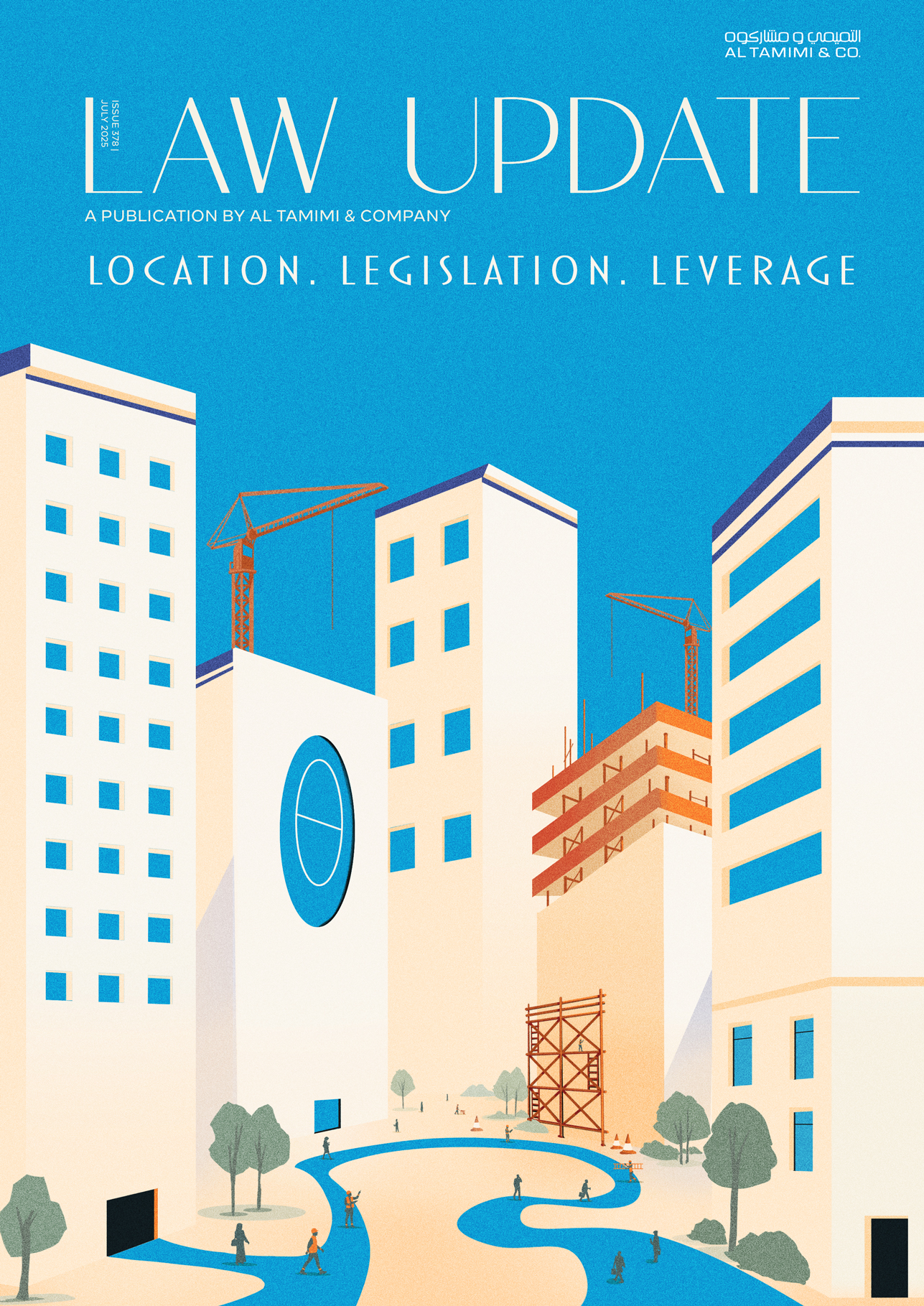- Arbitration
- Banking & Finance
- Capital Markets
- Commercial
- Competition
- Construction & Infrastructure
- Corporate / Mergers & Acquisitions
- Corporate Services
- Corporate Structuring
- Digital & Data
- Dispute Resolution
- Employment & Incentives
- Family Business & Private Wealth
- Innovation, Patents & Industrial Property (3IP)
- Insurance
Find a Lawyer
Book an appointment with us, or search the directory to find the right lawyer for you directly through the app.
Find out more
Real Estate & Construction and Hotels & Leisure
Real estate, construction, and hospitality are at the forefront of transformation across the Middle East – reshaping cities, driving investment, and demanding increasingly sophisticated legal frameworks.
In the June edition of Law Update, we take a closer look at the legal shifts influencing the sector – from Dubai’s new Real Estate Investment Funds Law and major reforms in Qatar, to Bahrain’s push toward digitalisation in property and timeshare regulation. We also explore practical issues around strata, zoning, joint ventures, and hotel management agreements that are critical to navigating today’s market.
As the landscape becomes more complex, understanding the legal dynamics behind these developments is key to making informed, strategic decisions.


2025 is set to be a game-changer for the MENA region, with legal and regulatory shifts from 2024 continuing to reshape its economic landscape. Saudi Arabia, the UAE, Egypt, Iraq, Qatar, and Bahrain are all implementing groundbreaking reforms in sustainable financing, investment laws, labor regulations, and dispute resolution. As the region positions itself for deeper global integration, businesses must adapt to a rapidly evolving legal environment.
Our Eyes on 2025 publication provides essential insights and practical guidance on the key legal updates shaping the year ahead—equipping you with the knowledge to stay ahead in this dynamic market.
The leading law firm in the Middle East & North Africa region.
A complete spectrum of legal services across jurisdictions in the Middle East & North Africa.
-
Practices
- All Practices
- Banking & Finance
- Capital Markets
- Commercial
- Competition
- Construction & Infrastructure
- Corporate / Mergers & Acquisitions
- Corporate Services
- Corporate Structuring
-
Sectors
-
Country Groups
-
Client Solutions
Today's news and tomorrow's trends from around the region.
17 offices across the Middle East & North Africa.
Our Services
 Back
Back
-
Practices
- All Practices
- Banking & Finance
- Capital Markets
- Commercial
- Competition
- Construction & Infrastructure
- Corporate / Mergers & Acquisitions
- Corporate Services
- Corporate Structuring
- Digital & Data
- Dispute Resolution
- Employment & Incentives
- Family Business & Private Wealth
- Innovation, Patents & Industrial Property (3IP)
- Insurance
- Intellectual Property
- Legislative Drafting
- Private Client Services
- Private Equity
- Private Notary
- Projects
- Real Estate
- Regulatory
- Tax
- Turnaround, Restructuring & Insolvency
- Compliance, Investigations and White-Collar Crime
-
Sectors
-
Country Groups
-
Client Solutions
- Law Firm
- /
- Insights
- /
- Law Update
- /
- October 2015
- /
- Regulatory Capital Bond and Sukuk Issuances in Qatar
Regulatory Capital Bond and Sukuk Issuances in Qatar
Rafiq Jaffer
-
Partner, Banking & Finance (Bahrain, KSA & UAE) Head – Debt Capital Markets
-
Banking and Finance
October 2015
The Committee’s stated objectives were to (a) improve the banking sector’s ability to absorb shocks arising from financial and economic stress, whatever the source; (b) improve risk management and governance; and (c) to strengthen banks’ transparency and disclosures. One of the key recommendations of the Committee related to the necessity for higher global minimum capital standards for commercial banks
In response the Qatar Central Bank issued Circulars 3/2014 (relating to conventional banks) and 6/2014 (relating to Islamic banks) (“Capital Regulations”) implementing minimum capital adequacy requirements in accordance with the Basel III Framework. In summary, banks in Qatar are required (from 31 March 2014) to maintain a minimum Capital Adequacy Ratio (aggregate of Tier 1 and Tier 2 capital) of 12.5%. The total minimum Capital Adequacy Ratio should consist of Tier 1 Capital (the aggregate of common equity Tier 1 capital and Additional Tier 1 capital) of at least 10.5%. The Capital Regulations also specified an implementation timetable between 2014 and 2019.
Contingent Convertible Bonds (CoCos)
Certain types of debt instruments known as contingent convertible bonds (CoCos) are categorised by the Qatar Central Bank as Additional Tier 1 capital. CoCos are debt securities (bonds, notes, Sukuk) that can be converted into shares of the issuing entity upon the occurrence of certain trigger events. The terms and conditions of all CoCos (that are to be classified as Additional Tier 1 capital) must have a provision that requires such instruments, at the option of the Qatar Central Bank, to either be written off or converted into shares upon the occurrence of certain trigger events. The first trigger event is that the issuer would become non-viable if the conversion or write-off was not effected. The second trigger is the decision to make a public sector injection of capital, or equivalent support without which the issuer would become non-viable. Any conversion of the CoCos would occur only on the direction of the Qatar Central Bank and on occurrence of one of the trigger events. These feature are referred to as loss absorption features.
In addition to the loss absorption features noted above, CoCos are subordinate to depositors and other unsecured creditors of the issuer and the Qatar Central Bank has the discretion to cancel coupon payments.
Legal Issues with CoCos
The Commercial Companies Law (Law No 11 of 2015) sets out the provisions relating to issuance of bonds by joint stock companies. The Commercial Companies Law contains specific provisions relating to convertible bonds including the corporate and regulatory approvals that are required to be adhered to. Therefore, there is a legal basis for the issuance of CoCos in Qatar. However, there are two potential issues that should be considered when structuring a CoCo issuance.
Article 177 of the Commercial Companies Law states that where the issuer has resolved to convert bonds into shares, the bondholders should have the option of collecting the principal amount or accepting shares. This provision presents a potential contradiction in the context of a conversion of CoCos into shares. Where the issuer of the CoCos is facing insolvency, the bondholder would prefer to collect the principal amount (given the option) rather than the shares of the issuer. Article 177 would have to be carefully dealt with at the time of drafting the terms of a CoCo issuance.
The other potential problem relates to the increase of share capital at the time of conversion. Article 191 of the Commercial Companies Law requires any resolution of the extraordinary meeting of shareholders to be held not more than one year prior to the proposed increase in share capital. This would require the cooperation of the shareholders at the time of the conversion of the CoCos into shares of the issuer.
Features of CoCos as Additional Tier 1 Capital
The Capital Regulations specify certain criteria that should be met by banks in order for their debt issuances to qualify for inclusion as Additional Tier 1 Capital. The following is a summary of the significant features of such issuances:
- The instruments should be subordinated to depositors, general creditors and subordinated debt of the bank.
- The instruments should not be secured or guaranteed.
- The instruments should be perpetual i.e there is no maturity date and there are no step-ups or incentives to redeem.
- The instruments may be callable at the initiative of the Issuer only after a minimum of five years:
– to exercise a call option the Issuer must receive prior approval of the Qatar Central Bank; and
– the issuer must not do anything which creates an expectation that the call will be exercised. - Coupon discretion:
– the Qatar Central Bank and the Issuer must have full discretion at all times to cancel distributions/payments;
– cancellation of discretionary payments must not be an event of default;
– the Issuer must have full access to cancelled payments to meet obligations as they fall due;
– cancellation of distributions/payments must not impose restrictions on the bank except in relation to distributions to common stockholders; and
– the instruments must not have credit sensitive dividends, that is the coupon that is reset periodically should not be based in whole or in part on the Issuer’s credit standing. - The terms of the instrument must contain a provision that requires such instruments, at the option of the Qatar Central Bank, to either be written off or converted into common stock upon occurrence of the following events:
– the Issuer would become non-viable without the write-off;
– the decision to make a public sector injection of capital, or equivalent support without which the Issuer would become non-viable.
The primary draw of such instruments is the quality of the bank that is the issuer and higher (anticipated) coupon payments. These instruments have been widely issued by banks in the GCC and market participants expect issuances to continue in the near future.
A version of this article was first published in IFLR Magazine September 2015.
Stay updated
To learn more about our services and get the latest legal insights from across the Middle East and North Africa region, click on the link below.


